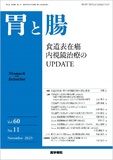Japanese
English
- 有料閲覧
- Abstract 文献概要
- 1ページ目 Look Inside
- 参考文献 Reference
要旨●Barrett食道腺癌は,Barrett粘膜から発生した腺癌と定義される.本邦ではBarrett粘膜の定義に腸上皮化生を必須としない,squamous dysplasiaに対応する項目がないなど,欧米とは病理学的定義や用語が異なっている.Low-grade dysplasiaは非腫瘍粘膜あるいは上皮内癌に主に分類され,high-grade dysplasiaは腺癌と診断される.表在癌の病理診断では,粘膜筋板の二重化に伴った特殊な深達度判定(深層粘膜筋板,粘膜下組織への浸潤の有無),扁平上皮下に拡がる腺癌の所見について理解しておく必要があり,p53の免疫組織化学染色は非腫瘍性病変との鑑別に有用なことが多い.今後は,本邦と欧州の異なる背景を理解しつつ,科学的根拠に基づいた統一的な診断基準の確立が期待される.
The pathological definitions and terminology used in the diagnosis of esophageal adenocarcinoma arising in Barrett's esophagus differ between Japan and Western countries. For example, in Japan, intestinal metaplasia is not required for the diagnosis of Barrett's esophagus, and—unlike in Western countries—the Japanese classification system does not include a dedicated category for dysplasia. In Japan, low-grade dysplasia is classified either as non-neoplastic mucosa or as adenocarcinoma in situ, whereas high-grade dysplasia is usually diagnosed as adenocarcinoma. Understanding the unique diagnostic categories based on the depth of invasion relative to the duplicated muscularis mucosae—such as invasion of the deep muscularis mucosae and submucosa—is essential for accurate diagnosis of superficial esophageal adenocarcinoma arising in Barrett's esophagus. Careful attention is also warranted in cases of adenocarcinoma extending beneath the squamous epithelium. Immunohistochemical staining for p53 is often useful for differentiating between neoplastic and non-neoplastic lesions. Ultimately, the establishment of a unified diagnostic standard, based on scientific evidence and mindful of the different medical traditions in Japan and Western countries, is necessary.

Copyright © 2025, Igaku-Shoin Ltd. All rights reserved.


